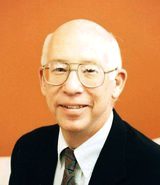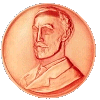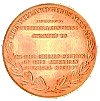
 |
| Gibbs
Award Dinner Friday, May 20, 2011 |
|---|
| Gibbs
Medal Awardee: Prof. Robert G. Bergman |
 |
|
|
“Selective Stoichiometric and Catalytic Reactions in Water-Soluble Host-Guest Supramolecular Systems” |
|
Date: Friday, May 20, 2011
Location: Casa Royale
783 Lee Street
Des Plaines, IL
Cost for the dinner: $40 per person, $20 for students, unemployed and retirees.Dinner reservations are required and should be received in the Section Office via phone (847-391-9091), email (chicagoacs@ameritech.net), or web by noon on Monday, May 16. PLEASE HONOR YOUR RESERVATIONS. The Section must pay for all food orders. No-shows will be billed. Seating will be available for those who wish to attend only the meeting.
6:00 PM Social Hour with hors d'œuvres and 2 complimentary drinks
7:00 PM Dinner
8:30 PM ACS Event Introduction
8:45 PM Gibbs Award Lecture
 |
The History of the Willard Gibbs Award |
 |
|---|
The Citation:
Introducing Professor Bergman: Dr. Charles (Chuck) Casey, University of Wisconsin, Gibbs Juror
Presentation of the medal: Dr. William (Bill) Carroll, 2005 President of the ACS, Gibbs Juror
Gibbs Acceptance Address: “Selective Stoichiometric and Catalytic Reactions in Water-Soluble Host-Guest Supramolecular Systems”
Abstract:
In a collaborative study being carried out by the R. G. Bergman and K. N. Raymond research groups, several cationic organic and organometallic compounds have been shown to bind into the cavities of water-soluble chiral clusters or “nanovessels” (constructed earlier by the Raymond group) from metal salts and dicatecholate bridging ligands. Among these are reactive Ir(III) complexes that undergo Ir(III)/Ir(V) C-H oxidative addition reactions (discovered earlier by the R. G. Bergman group) when they are encapsulated in the nanovessel clusters in aqueous solution, leading to the first nanovessel intracavity C-H activation reactions. Substantial size- and shape selectivities have been observed in these reactions. Subsequently, aza-Cope and other pericyclic rearrangements have been found to proceed in the nanovessel cavities; small quantitities of the nanovessels have been found to catalyze these reactions with accelerations above 800-fold. Nanovessels have also been found to perturb the acidities of organic bases, and the pKa-shift properties of the nanovessels has provided a way of carrying out acid-catalyzed hydrolyses in strongly basic aqueous solution. For example, the nanovessels strongly catalyze the aqueous hydrolyses of orthoformates and acetals at high pH with even larger accelerations (>3000-fold) than those seen for the aza-Cope rearrangement. The velocities of the hydrolysis reactions mirror the classic rate behavior of enzymes, including adherence to Michaelis-Menten kinetics and exhibition of competitive inhibition by strongly-binding guests. Most recently, nanovessel-catalyzed Nazarov rearrangements have been discovered, proceeding with unprecedented accelerations of up to two million, and enantioselective transformations catalyzed by chiral nanovessels have also been found.
Biography:
Ph.D.: University of Wisconsin 1966 (with Jerome A. Berson); postdoctoral: Columbia University 1966-67 (with Ronald Breslow). Faculty positions: Assistant professor to Professor, California Institute of Technology (1967-78); Professor, University of California, Berkeley (joint appointment with Lawrence Berkeley National Laboratory) 1978 – 2002; Gerald E.K. Branch Distinguished Professor, UC Berkeley, 2002 - present. Awards include: Sloan Fellowship, Dreyfus Teacher-Scholar Award, American Chemical Society Award in Organometallic Chemistry, election to National Academy of Sciences and American Academy of Arts and Sciences, DOE E.O. Lawrence Award in Chemistry, ACS Arthur C. Cope Award, Royal Society of Chemistry Sir Edward Frankland Prize Lectureship. Research summary: Bergman has long been interested in exploratory and mechanistic studies in organic and organotransition metal chemistry. He is probably best known for his discovery of the thermal cyclization of cis-1,5-hexadiyne-3-enes to 1,4-dehydrobenzene diradicals, later identified as a crucial DNA-cleaving reaction in several antibiotics, discovery of the first soluble organometallic complexes that undergo intermolecular insertion of transition metals into the carbon-hydrogen bonds of alkanes, and the synthesis and cycloaddition reactions of complexes with metal-heteroatom multiple bonds. Other recent interests: application of C-H bond activation in synthetic organic chemistry, nanovessel catalysis; methods for the conversion of biomass to fuels and commodity chemicals.
Parking: Free
Dinner:
| Last updated 4/4/11 Copyright © 2009-2011, Chicago Section, The American Chemical Society |
Webs by Wizardcraft |